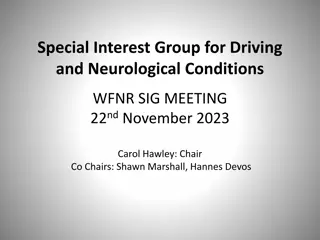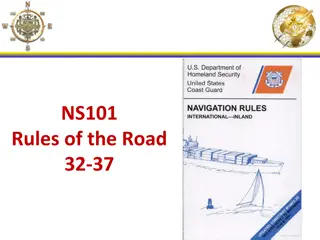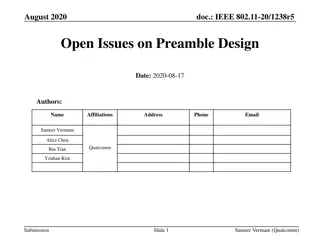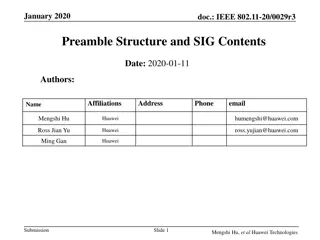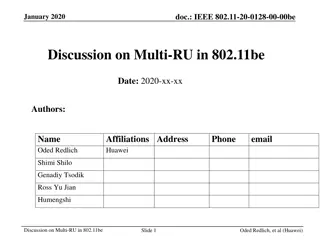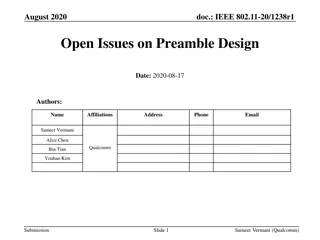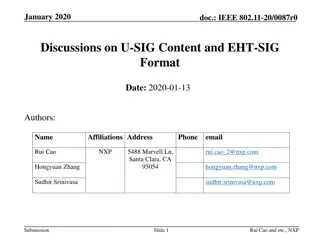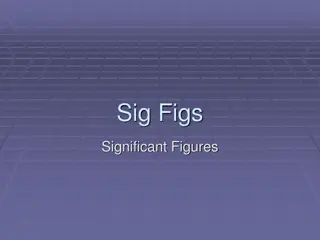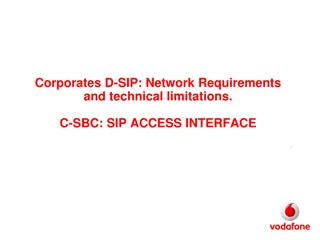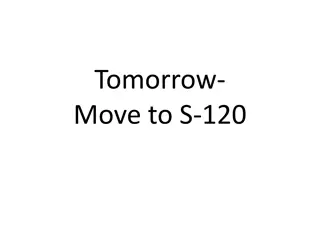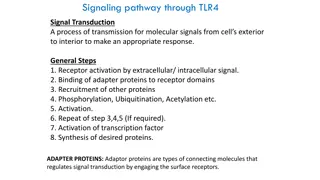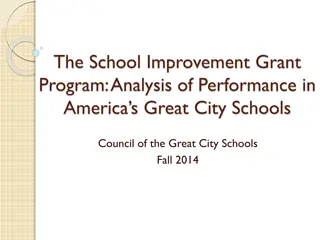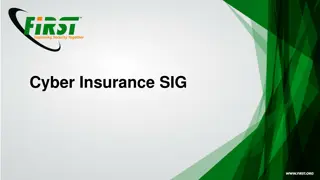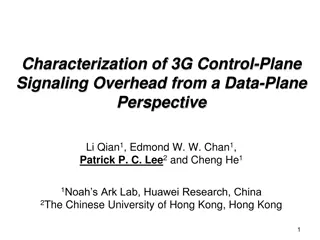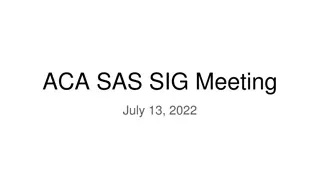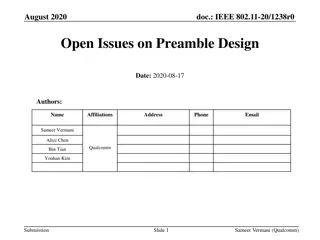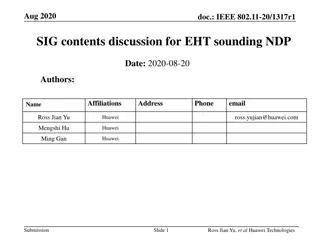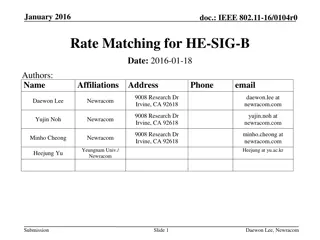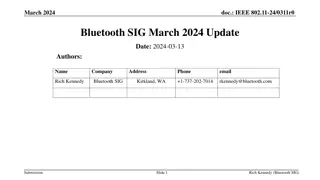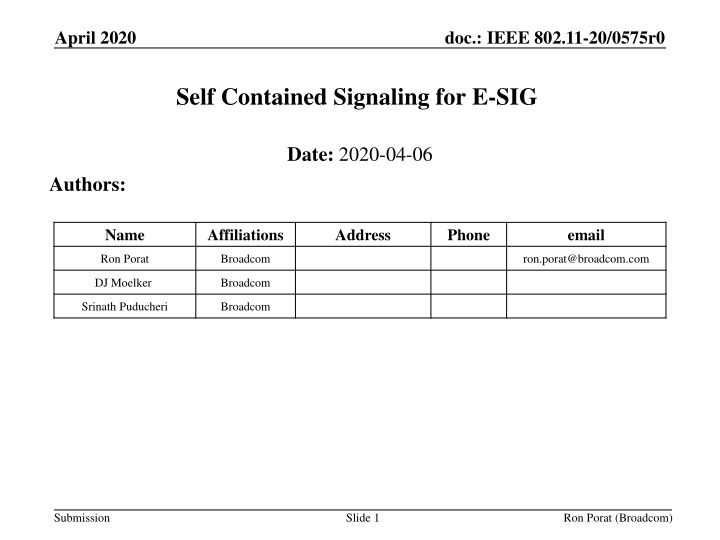
Self-Contained Signaling Proposal for IEEE 802.11 E-SIG
Explore the innovative self-contained signaling proposal for IEEE 802.11 E-SIG, aiming to simplify design, enhance flexibility, and streamline standardization and implementation processes. The proposal suggests replacing RU tables with user-specific tables for a more efficient and logical approach, especially beneficial for supporting non-contiguous RU and higher bandwidth scenarios. The discussion also touches upon compression modes and their relevance in E-SIG design within the context of 11be standards.
Download Presentation

Please find below an Image/Link to download the presentation.
The content on the website is provided AS IS for your information and personal use only. It may not be sold, licensed, or shared on other websites without obtaining consent from the author. If you encounter any issues during the download, it is possible that the publisher has removed the file from their server.
You are allowed to download the files provided on this website for personal or commercial use, subject to the condition that they are used lawfully. All files are the property of their respective owners.
The content on the website is provided AS IS for your information and personal use only. It may not be sold, licensed, or shared on other websites without obtaining consent from the author.
E N D
Presentation Transcript
April 2020 doc.: IEEE 802.11-20/0575r0 Self Contained Signaling for E-SIG Date: 2020-04-06 Authors: Name Affiliations Address Phone email Ron Porat Broadcom ron.porat@broadcom.com DJ Moelker Broadcom Srinath Puducheri Broadcom Submission Slide 1 Ron Porat (Broadcom)
April 2020 doc.: IEEE 802.11-20/0575r0 Abstract We have seen many proposals so far on E-SIG design. Most proposals enhance SIG- B design to support M-RU, e.g. by designing a bigger RU table. In here we would like to propose a self-contained design that builds on the trigger frame design philosophy and the per-user field already in SIG-B Submission Slide 2 Ron Porat (Broadcom)
April 2020 doc.: IEEE 802.11-20/0575r0 High Level Idea (1) Instead of enhancing the common field in SIG-B, we get rid of the RU tables in the common field and enhance the user-specific field by adding a table similar to the one used in the trigger frame user fields become self-contained Why that could be a better option? Self-contained solution is simpler and more elegant and in the end could offer a quicker path to standardization and implementation. In other words after all enhancements and design details are added to the common field it could be simpler to just omit it. Submission Slide 3 Ron Porat (Broadcom)
April 2020 doc.: IEEE 802.11-20/0575r0 High Level Idea (2) Self-contained design is more suitable for the concept of users parking on S80 STA doesn t need to know what s happening in other parts of BW and AP has flexibility of signaling on each S80 different users without the need for specific signaling. Self-contained design is more logical for supporting non-contiguous RU since RU table design means left to right sequential mapping (including punctured channels). RU tables were built mostly to support small RU in 20/40/80MHz , in fact most entries in the table are for small RU. However 11be is focusing on higher BW and the importance of small RU in that case is reduced. Indeed with the latest FCC announcement it seems likely that we can have three or four 320MHz channels in the US in LPI mode. RU tables present a fixed overhead that increases with BW irrespective of # of users. For same # of users the higher the BW the higher the overhead. This is somewhat counter productive design choices and logic used in 11ax not natural for 11be. Submission Slide 4 Ron Porat (Broadcom)
April 2020 doc.: IEEE 802.11-20/0575r0 A Note on Compression Modes Compression modes are used in 11ax and provide the best of both worlds no common field RU tables and no per-user RU tables. We fully support the idea of using compression modes for 11be E-SIG design and the discussion in this contribution focuses on the non-compression modes, namely OFDMA or MU-MIMO+OFDMA. Submission Slide 5 Ron Porat (Broadcom)
April 2020 doc.: IEEE 802.11-20/0575r0 Overhead Comparisons (1) When the number of users is large the current SIG-B design will be more efficient when compared to self-contained but: our view and focus is that typical scenarios will include up to 16 users, even with 320MHz BW, and in those scenarios we show that no scheme has big advantage Specifically in the following comparison for 320MHz we assume: 11ax-style new user field 22 bits + per user effective 5 bits for CRC+tail 27 bits E-SIG RU table 10bits each content channel common field is 102 bits! (2x(4RU tables x10bits +1+10 tail+crc)). We assume one tail+CRC for 100bits is too weak. Self-contained user field 33bits (9-10bits trigger like RU table) +10bits CRC+tail Option A - 43 bits (16 bits more than 11ax-style) Option B - if 2 users in one block 38 bits (11 bits more than 11ax-style) Breakeven points Option A - 102/16 = # of users per content channel ~13 users in total Option B 102/ 11= # of users per content channel 18.5 users in total Submission Slide 6 Ron Porat (Broadcom)
April 2020 doc.: IEEE 802.11-20/0575r0 Overhead Comparisons (2) For lower BW such as 160Mhz and 80 MHz the breakeven points are lower but some optimizations are possible. See Appendix. The plot below reflects that overhead calculation in 320 MHz for option A with perfect load balancing 800 700 Number of bits in EHTSIG (CC) 600 500 Self contained 32bit Self contained 33bit 400 11ax-style 9bit RU table 300 11ax-style 10bit RU table 200 11ax-style 11bit RU table 100 0 0 10 20 30 40 Number of users in the PPDU Submission Slide 7 Ron Porat (Broadcom)
April 2020 doc.: IEEE 802.11-20/0575r0 Overhead Comparison (3) - in Symbols 30 #EHTSIG symbols @MCS0 Lines are not straight because overhead is rounded up to integer symbols (so includes padding) Number of symbols in EHT SIG (CC) 25 20 Self contained 32bit Self contained 33bit 15 11ax-style 9bit RU table 10 11ax-style 10bit RU table 5 11ax-style 11bit RU table 0 0 10 20 30 40 Number of users in the PPDU 16 #EHTSIG symbols @MCS1 Minimal difference @MCS1 between methods Number of symbols in EHT SIG (CC) 14 12 10 Self contained 32bit Self contained 33bit 8 11ax-style 9bit RU table 6 11ax-style 10bit RU table 4 11ax-style 11bit RU table 2 0 0 10 20 30 40 Number of users in the PPDU Submission Slide 8 Ron Porat (Broadcom)
April 2020 doc.: IEEE 802.11-20/0575r0 Summary We have provided our reasons to consider in 11be a small change from 11ax design so that we better align the design with 11be goals of higher BW and managing STA parking on secondary channels We have shown that at least for 320MHz BW (a goal of rel.1), and the typical # of users we consider practical, overhead is roughly similar in terms of increased E-SIG duration especially if MCS1 is used. We recommend that the group takes a step back and consider both options pros and cons before making a decision on specific design choices Submission Slide 9 Ron Porat (Broadcom)
April 2020 doc.: IEEE 802.11-20/0575r0 SP Do you support a self-contained design for E-SIG? Yes No ABS Submission Slide 10 Ron Porat (Broadcom)
April 2020 doc.: IEEE 802.11-20/0575r0 Appendix - Overhead Comparison for 160MHz and 80MHz 14 160MHz 30bit more optimized table #EHTSIG symbols @MCS1 Number of symbols in EHT SIG (CC) 12 10 Self contained 30bit 8 Self contained 32bit 6 11ax-style 9bit RU table 4 11ax-style 10bit RU table 2 11ax-style 11bit RU table 0 0 10 20 30 40 Number of users in the PPDU 80MHz 29bit more optimized table 8 #EHTSIG symbols @MCS1 Number of symbols in EHT SIG (CC) 7 6 5 Self contained 29bit Self contained 31bit 4 11ax-style 9bit RU table 3 11ax-style 10bit RU table 2 11ax-style 11bit RU table 1 0 0 5 10 15 20 Number of users in the PPDU Submission Slide 11 Ron Porat (Broadcom)


